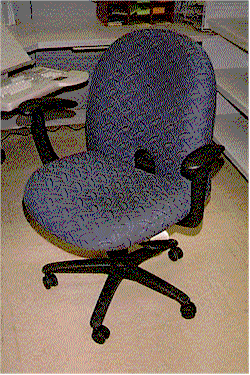
Cornell University Ergonomics Web

Cornell University Ergonomics Web
DEA 651: Evaluation of Proposed Ergonomic Workstations in Olin Library
Workstation #2: Evaluation
This page includes evaluation and images of Workstation #2.
Abstract | Workstation #1 | Workstation #2 | Workstation #3
Workstation #4 | Workstation #5 (C) | Existing Workstation
Posture Analysis | Reach Envelope
This Haworth workstation was evaluated using RULA analysis, VDT checklists, and subjective assessment. It was determined that the workstation was overall acceptable for activities such as data entry***, rating a RULA score of 3. However, more investigation is warranted in respect to particular concerns (i.e. problem areas) that arose during usability testing.
Subjective Assessment: Several good features of this
workstation revolve around aspects of adjustability. Examples of
this can be found in the keyboard tray being height-adjustable
and the monitor having side-to-side adjustability. Another good
feature, not relating to adjustability, is the presence of a
document holder which is positioned between the monitor
and the keyboard, directly in the user's line of vision.
A closer look targeted some problem areas. One problem area lies in the lack of height adjustability of the document holder, which is important for accommodating documents of various sizes. Why is this of concern? From our observations, the source of inputing for the user can vary greatly in document size. For small documents where the user needs to look down constantly -the user is unable to keep their head in a vertical orientation, which often creates stress in the neck area. By the same token, the height-static document holder is also not able to display large documents because it would obstruct the computer screen (see image).
Another concern involves the limited adjustablities of the mouse tray and the keyboard tray. Although it could move from side to side, the mouse tray lacked the height adjustability which could be found at other workstations. In contrast, although the keyboard tray is height adjustable, how to adjust the tray was not immediately obvious. This was due to a lack of visible instructions. Another negative feature of the keyboard tray is that it requires both hands to adjust it. Also, once the keyboard tray was adjusted to a work height that permitted the user to type with their upper body in a neutral position, i.e. at which the tray was resting at elbow height, the tray rested on the user's legs. This inadequate thigh clearance prevents the user from resting their knees in a comfortable position. In conjunction with these points, at their maximum positions, the mouse and keyboard tray obstruct each other.
 |
Final concerns that were observed
involved pressure points and reach. When the user rested
their forearms on the tray's wrist rest, this applied
pressure to the undersides of the user's wrists, creating
undesired pressure points. Reach is an issue caused by
the angles of the desk. Because of this shape, the user
is unable to reach items on either side of the monitor (see reach envelope). The chair (HAWORTH, model # G9-10-A-831-11341 TA-708, TR-F) seemed uncomfortable. Reasons for this included the seat back making the user's back hurt and when the user attempted to operate the mouse, the permanent, non-adjusting arm rests pressed against the undersides of the forearms uncomfortably. It was also deducted from further analysis that the non-adjusting armrests could also inhibit the use of the keyboard by a smaller-framed and/or a very large user. |
VDT Checklist: The VDT Posture Checklist of this Haworth workstation reinforced our primary observations through usability trials (listed above) but also shed light on other postural risks (-) and plusses (+). These include:
- due to the limited adjustability of the chair, the user is unable to rest their feet comfortably
- the limited adjustability of the workstation design in conjunction with the perceived job requirements can cause non-neutral body positions to be held over extended period of time
+ the width of the workstation is appropriate in that all required task accessories and duties are within viewing distance
+ the area under the desk is large enough to accommodate legs and accessories such as footrests
- the user is unable to adjust the height of the monitor
+ the user is able to adjust the fore-aft distance of the monitor
+ the keystroke pressure was comfortable to the user
+ the user is able to operate the mouse (though obstructing the number pad) without extended or repetitive reaching
+ the document holder prevents the document from vibrating
- a footrest is not available to the user
+ a task light is available to the user
- the task light did not have a diffuser to combat glare
+ the worksurface had a matte finish, which reduced light reflection
In conclusion, although our initial impressions and subjective evaluation were primarily negative, the RULA analysis and VDT checklists provided positive aspects of the Haworth design. This leads us to believe that the Haworth workstation does have its merits, however further investigation is needed into the concerns discussed above.
***Please note that due to time constraints, the above analysis was performed in respect to data entry only, the primary task performed at this workstation. Further investigation may be required if other tasks are to be considered.
Abstract | Workstation #1 | Workstation #2 | Workstation #3
Workstation #4 | Workstation #5 (C) | Existing Workstation
Posture Analysis | Reach Envelope
This page created by DEA 651: Ergonomics,
Anthropometrics, and Biomechanics,
Send questions or comments to rlp6@cornell.edu.
Last updated January 25, 2009